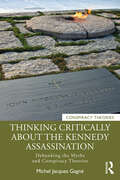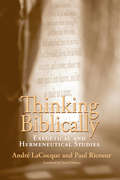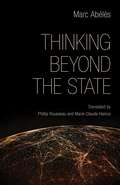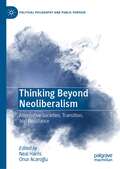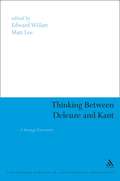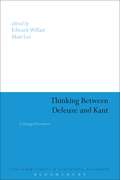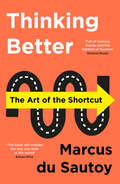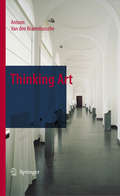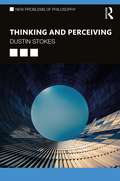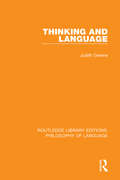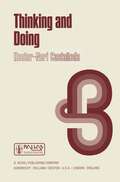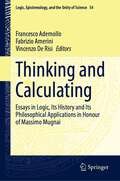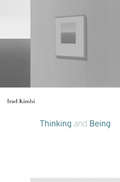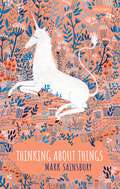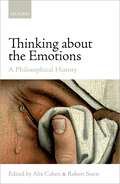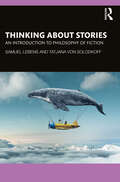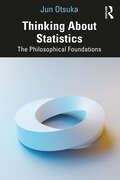- Table View
- List View
Thinking Critically About the Kennedy Assassination: Debunking the Myths and Conspiracy Theories (Conspiracy Theories)
by Michel Jacques GagnéThinking Critically About the Kennedy Assassination uses the tools of critical thinking, historical research, and philosophical inquiry to debunk the many myths and conspiracy theories surrounding JFK’s shocking and untimely death. As we approach the 60th anniversary of the violent public assassination of President John F. Kennedy, over half of all Americans surveyed continue to believe that he was killed by a conspiracy involving multiple assassins. Through its reasoned and detailed analysis of the content and evolution of JFK conspiracy narratives, this book also serves as a comprehensive case study of paranoid reasoning and modern mythmaking. The book’s opening chapters lay out the "official" academic consensus concerning the Kennedy assassination (better known as the "Lone Gunman Theory") and discuss the origins of popular interpretations of Kennedy’s life and death, such as the nostalgic myth of "Camelot," the unsympathetic "Irish Mafia" narrative, and the many conspiracy theories critical of both. Subsequent sections scrutinize the alleged motives of leading conspiracy suspects, the ballistic, forensic, and medical evidence related to JFK’s murder, and the most popular "proofs" of an enduring government cover- up. The book concludes that no clear evidence exists to suggest that JFK was the victim of a conspiracy and ends with a discussion of the causes and consequences of paranoid thinking in contemporary public discourse. This volume will appeal to students of history, politics, psychology, and cultural and media studies, and to a broader audience interested in American history, critical thinking, and conspiracy thinking.
Thinking Critically About the Kennedy Assassination: Debunking the Myths and Conspiracy Theories (Conspiracy Theories)
by Michel Jacques GagnéThinking Critically About the Kennedy Assassination uses the tools of critical thinking, historical research, and philosophical inquiry to debunk the many myths and conspiracy theories surrounding JFK’s shocking and untimely death. As we approach the 60th anniversary of the violent public assassination of President John F. Kennedy, over half of all Americans surveyed continue to believe that he was killed by a conspiracy involving multiple assassins. Through its reasoned and detailed analysis of the content and evolution of JFK conspiracy narratives, this book also serves as a comprehensive case study of paranoid reasoning and modern mythmaking. The book’s opening chapters lay out the "official" academic consensus concerning the Kennedy assassination (better known as the "Lone Gunman Theory") and discuss the origins of popular interpretations of Kennedy’s life and death, such as the nostalgic myth of "Camelot," the unsympathetic "Irish Mafia" narrative, and the many conspiracy theories critical of both. Subsequent sections scrutinize the alleged motives of leading conspiracy suspects, the ballistic, forensic, and medical evidence related to JFK’s murder, and the most popular "proofs" of an enduring government cover- up. The book concludes that no clear evidence exists to suggest that JFK was the victim of a conspiracy and ends with a discussion of the causes and consequences of paranoid thinking in contemporary public discourse. This volume will appeal to students of history, politics, psychology, and cultural and media studies, and to a broader audience interested in American history, critical thinking, and conspiracy thinking.
Thinking Biblically: Exegetical and Hermeneutical Studies
by André LaCocque Paul RicoeurUnparalled in its poetry, richness, and religious and historical significance, the Hebrew Bible has been the site and center of countless commentaries, perhaps none as unique as Thinking Biblically. This remarkable collaboration sets the words of a distinguished biblical scholar, André LaCocque, and those of a leading philosopher, Paul Ricoeur, in dialogue around six crucial passages from the Old Testament: the story of Adam and Eve; the commandment "thou shalt not kill"; the valley of dry bones passage from Ezekiel; Psalm 22; the Song of Songs; and the naming of God in Exodus 3:14. Commenting on these texts, LaCocque and Ricoeur provide a wealth of new insights into the meaning of the different genres of the Old Testament as these made their way into and were transformed by the New Testament. LaCocque's commentaries employ a historical-critical method that takes into account archaeological, philological, and historical research. LaCocque includes in his essays historical information about the dynamic tradition of reading scripture, opening his exegesis to developments and enrichments subsequent to the production of the original literary text. Ricoeur also takes into account the relation between the texts and the historical communities that read and interpreted them, but he broadens his scope to include philosophical speculation. His commentaries highlight the metaphorical structure of the passages and how they have served as catalysts for philosophical thinking from the Greeks to the modern age. This extraordinary literary and historical venture reads the Bible through two different but complementary lenses, revealing the familiar texts as vibrant, philosophically consequential, and unceasingly absorbing.
Thinking beyond the State
by Marc AbélèsThe French scholar Marc Abélès is one of the leading political and philosophical anthropologists of our time. He is perhaps the leading anthropologist writing on the state and globalization. Thinking beyond the State, a distillation of his work to date, is a superb introduction to his contributions to both anthropology and political philosophy. Abélès observes that while interdependence and interconnection have become characteristic features of our globalized era, there is no indication that a concomitant evolution in thinking about political systems has occurred. The state remains the shield—for both the Right and the Left—against the turbulent effects of globalization. According to Abélès, we live in a geopolitical universe that, in many respects, reproduces alienating logics. His book, therefore, is a primer on how to see beyond the state. It is also a testament to anthropology’s centrality and importance in any analysis of the global human predicament. Thinking beyond the State will find wide application in anthropology, political science and philosophy courses dealing with the state and globalization.
Thinking Beyond Neoliberalism: Alternative Societies, Transition, and Resistance (Political Philosophy and Public Purpose)
by Neal Harris Onur AcaroğluThis book brings together leading academics and activists to address the possibilities for qualitative social change beyond neoliberalism, providing introductory essays on alternative societies, transition, and resistance. Bringing together discussions on universal basic income, actually existing communism, parecon, circular economies, workers co-operatives, ‘fully automated luxury communism,' trade unionism, and party politics, the volume provides one of the first scholarly interventions to systematically evaluate possibilities for transition and resistance across theoretical, political, and disciplinary traditions.
Thinking Between Deleuze and Kant: A Strange Encounter (Continuum Studies in Continental Philosophy)
by Edward Willatt Matt LeeIn the wake of much previous work on Gilles Deleuze's relations to other thinkers (including Bergson, Spinoza and Leibniz), his relation to Kant is now of great and active interest and a thriving area of research. In the context of the wider debate between 'naturalism' and 'transcendental philosophy', the implicit dispute between Deleuze's 'transcendental empiricism' and Kant's 'transcendental idealism' is of prime philosophical concern. Bringing together the work of international experts from both Deleuze scholarship and Kant scholarship, Thinking Between Deleuze and Kant addresses explicitly the varied and various connections between these two great European philosophers, providing key material for understanding the central philosophical problems in the wider 'naturalism/ transcendental philosophy' debate. The book reflects an area of great current interest in Deleuze Studies and initiates an ongoing interest in Deleuze within Kant scholarship. The contributors are Mick Bowles, Levi R. Bryant, Patricia Farrell, Christian Kerslake, Matt Lee, Michael J. Olson, Henry Somers-Hall and Edward Willatt.
Thinking Between Deleuze and Kant: A Strange Encounter (Continuum Studies in Continental Philosophy #227)
by Edward Willatt Matt LeeIn the wake of much previous work on Gilles Deleuze's relations to other thinkers (including Bergson, Spinoza and Leibniz), his relation to Kant is now of great and active interest and a thriving area of research. In the context of the wider debate between 'naturalism' and 'transcendental philosophy', the implicit dispute between Deleuze's 'transcendental empiricism' and Kant's 'transcendental idealism' is of prime philosophical concern. Bringing together the work of international experts from both Deleuze scholarship and Kant scholarship, Thinking Between Deleuze and Kant addresses explicitly the varied and various connections between these two great European philosophers, providing key material for understanding the central philosophical problems in the wider 'naturalism/ transcendental philosophy' debate. The book reflects an area of great current interest in Deleuze Studies and initiates an ongoing interest in Deleuze within Kant scholarship. The contributors are Mick Bowles, Levi R. Bryant, Patricia Farrell, Christian Kerslake, Matt Lee, Michael J. Olson, Henry Somers-Hall and Edward Willatt.
Thinking Better: The Art Of The Shortcut
by Marcus du SautoyHow do you remember more and forget less? How can you earn more and become more creative just by moving house? And how do you pack a car boot most efficiently? This is your shortcut to the art of the shortcut.
Thinking Art: An Introduction To Philosophy Of Art
by Antoon van den BraembusscheIn the twentieth century, avant-garde movements have pushed the concept of art far beyond its traditional boundaries. In this dynamical process of constant renewal the prestige of thinking about art as a legitimizing practice has come to the fore. So it is hardly surprising that the past decades have been characterized by a revival or even breakthrough of philosophy of art as a discipline. However, the majority of books on aesthetics fail to combine a systematical philosophical discourse with a real exploration of art practice. Thinking Art attempts to deal with this traditional shortcoming. It is indeed not only an easily accessible and systematic account of the classical, modern and postmodern theories of art, but also concludes each chapter with an artist’s studio in which the practical relevance of the discussed theory is amply demonstrated by concrete examples. Moreover, each chapter ends with a section on further reading, in which all relevant literature is discussed in detail. Thinking Art provides its readers with a theoretical framework that can be used to think about art from a variety of perspectives. More particularly it shows how a fruitful cross-fertilization between theory and practice can be created. This book can be used as a handbook within departments of philosophy, history of art, media and cultural studies, cultural history and, of course, within art academies. Though the book explores theories of art from Plato to Derrida it does not presuppose any acquaintance with philosophy from its readers. It can thus be read also by artists, art critics, museum directors and anyone interested in the meaning of art.
Thinking and Perceiving (New Problems of Philosophy)
by Dustin StokesHuman beings are in contact with the world through their minds. One can make sensory perceptual contact with the world: One sees the tree and hears its leaves flutter. And one makes cognitive contact with the world: One forms beliefs about the tree, memories of how it was in the past, and expectations of how it will be in the future. Can the first, perception, be influenced in important ways by the second, cognition? Do cognitive states such as memories, beliefs, and expectations affect what one perceives through the senses? And what is the importance of these possible relations to how we theorize and understand the human mind? Possible cognitive influence on perception (sometimes called "cognitive penetration of perception") has been long debated in philosophy of mind and cognitive science: Some argue that such influence occurs, while others argue that it does not or cannot. In this excellent introduction and overview of the problem, Dustin Stokes examines the following: The philosophical and scientific background to cognition and perception Contemporary ways of distinguishing cognition and perception Questions about the representational content of perception versus cognition Distinct theories of mental architecture: modularity versus malleability Consequences for epistemology, philosophy of science, and aesthetics Philosophical and scientific research on perceptual attention Perceptual skill, learning, and expertise Perceptual content, objectivity, and cultural bias. Additional features, such as chapter summaries, suggestions for further reading, and a glossary, make Thinking and Perceiving an ideal resource for students of philosophy of mind and psychology, cognitive psychology, and cognitive science.
Thinking and Perceiving (New Problems of Philosophy)
by Dustin StokesHuman beings are in contact with the world through their minds. One can make sensory perceptual contact with the world: One sees the tree and hears its leaves flutter. And one makes cognitive contact with the world: One forms beliefs about the tree, memories of how it was in the past, and expectations of how it will be in the future. Can the first, perception, be influenced in important ways by the second, cognition? Do cognitive states such as memories, beliefs, and expectations affect what one perceives through the senses? And what is the importance of these possible relations to how we theorize and understand the human mind? Possible cognitive influence on perception (sometimes called "cognitive penetration of perception") has been long debated in philosophy of mind and cognitive science: Some argue that such influence occurs, while others argue that it does not or cannot. In this excellent introduction and overview of the problem, Dustin Stokes examines the following: The philosophical and scientific background to cognition and perception Contemporary ways of distinguishing cognition and perception Questions about the representational content of perception versus cognition Distinct theories of mental architecture: modularity versus malleability Consequences for epistemology, philosophy of science, and aesthetics Philosophical and scientific research on perceptual attention Perceptual skill, learning, and expertise Perceptual content, objectivity, and cultural bias. Additional features, such as chapter summaries, suggestions for further reading, and a glossary, make Thinking and Perceiving an ideal resource for students of philosophy of mind and psychology, cognitive psychology, and cognitive science.
Thinking and Language
by Judith GreeneOriginally published in 1875, this book discusses thinking and language and traces the development of different pscyological approaches, assessing their theoretical significance and the experimental evidence behind them. It ends by drawing together the various lines of argument to arrive at some general conclusions about language and thought, since it clearly emerges that the two are inextricably linked.
Thinking and Language: Topics In Cognitive Psychology (Psychology Library Editions: Memory Ser.)
by Judith GreeneOriginally published in 1875, this book discusses thinking and language and traces the development of different pscyological approaches, assessing their theoretical significance and the experimental evidence behind them. It ends by drawing together the various lines of argument to arrive at some general conclusions about language and thought, since it clearly emerges that the two are inextricably linked.
Thinking and Doing: The Philosophical Foundations of Institutions (Philosophical Studies Series #7)
by Hector-Neri CastañedaPhilosophy is the search for the large patterns of the world and of the large patterns of experience, perceptual, theoretical, . . . , aesthetic, and practical - the patterns that, regardless of specific contents, characterize the main types of experience. In this book I carry out my search for the large patterns of practical experience: the experience of deliberation, of recognition of duties and their conflicts, of attempts to guide other person's conduct, of deciding to act, of influencing the physical world with one's doings, and the like. This is the experience that makes possible our social life, the formulation of plans for teamwork, the building of institutions, the development of nations, and the adoption of the ideal of morality. Here I develop a network of theories about the most fundamental aspects of practical thinking: what is thought in such thinking; what makes that thinking correct; what makes it practical; and the structure of the doings that accrue to the world when such thinking is effective. I have attempted to build each theory in sufficient detail, so that it il luminates its subject matter with a certain degree of fullness. But I have also aimed at producing an harmonious system of theories, so that the grand pattern of practical thinking can be admired, not only for the beauty of the separate structures of its parts, but also for its architectonic unity. Chapter 1 gives the details of the many facets of this project and discusses some methodological techniques.
Thinking and Calculating: Essays in Logic, Its History and Its Philosophical Applications in Honour of Massimo Mugnai (Logic, Epistemology, and the Unity of Science #54)
by Francesco Ademollo Fabrizio Amerini Vincenzo De RisiThis volume collects 22 essays on the history of logic written by outstanding specialists in the field. The book was originally prompted by the 2018-2019 celebrations in honor of Massimo Mugnai, a world-renowned historian of logic, whose contributions on Medieval and Modern logic, and to the understanding of the logical writings of Leibniz in particular, have shaped the field in the last four decades. Given the large number of recent contributions in the history of logic that have some connections or debts with Mugnai’s work, the editors have attempted to produce a volume showing the vastness of the development of logic throughout the centuries. We hope that such a volume may help both the specialist and the student to realize the complexity of the history of logic, the large array of problems that were touched by the discipline, and the manifold relations that logic entertained with other subjects in the course of the centuries. The contributions of the volume, in fact, span from Antiquity to the Modern Age, from semantics to linguistics and proof theory, from the discussion of technical problems to deep metaphysical questions, and in it the history of logic is kept in dialogue with the history of mathematics, economics, and the moral sciences at large.
Thinking and Being
by Irad KimhiOpposing a long-standing orthodoxy of the Western philosophical tradition running from ancient Greek thought until the late nineteenth century, Frege argued that psychological laws of thought—those that explicate how we in fact think—must be distinguished from logical laws of thought—those that formulate and impose rational requirements on thinking. Logic does not describe how we actually think, but only how we should. Yet by thus sundering the logical from the psychological, Frege was unable to explain certain fundamental logical truths, most notably the psychological version of the law of non-contradiction—that one cannot think a thought and its negation simultaneously. Irad Kimhi’s Thinking and Being marks a radical break with Frege’s legacy in analytic philosophy, exposing the flaws of his approach and outlining a novel conception of judgment as a two-way capacity. In closing the gap that Frege opened, Kimhi shows that the two principles of non-contradiction—the ontological principle and the psychological principle—are in fact aspects of the very same capacity, differently manifested in thinking and being. As his argument progresses, Kimhi draws on the insights of historical figures such as Aristotle, Kant, and Wittgenstein to develop highly original accounts of topics that are of central importance to logic and philosophy more generally. Self-consciousness, language, and logic are revealed to be but different sides of the same reality. Ultimately, Kimhi’s work elucidates the essential sameness of thinking and being that has exercised Western philosophy since its inception.
Thinking and Being
by Irad KimhiOpposing a long-standing orthodoxy of the Western philosophical tradition running from ancient Greek thought until the late nineteenth century, Frege argued that psychological laws of thought—those that explicate how we in fact think—must be distinguished from logical laws of thought—those that formulate and impose rational requirements on thinking. Logic does not describe how we actually think, but only how we should. Yet by thus sundering the logical from the psychological, Frege was unable to explain certain fundamental logical truths, most notably the psychological version of the law of non-contradiction—that one cannot think a thought and its negation simultaneously. Irad Kimhi’s Thinking and Being marks a radical break with Frege’s legacy in analytic philosophy, exposing the flaws of his approach and outlining a novel conception of judgment as a two-way capacity. In closing the gap that Frege opened, Kimhi shows that the two principles of non-contradiction—the ontological principle and the psychological principle—are in fact aspects of the very same capacity, differently manifested in thinking and being. As his argument progresses, Kimhi draws on the insights of historical figures such as Aristotle, Kant, and Wittgenstein to develop highly original accounts of topics that are of central importance to logic and philosophy more generally. Self-consciousness, language, and logic are revealed to be but different sides of the same reality. Ultimately, Kimhi’s work elucidates the essential sameness of thinking and being that has exercised Western philosophy since its inception.
Thinking about Things
by Mark SainsburyIn the blink of an eye, I can redirect my thought from London to Austin, from apples to unicorns, from former president Obama to the mythical flying horse, Pegasus. How is this possible? How can we think about things that do not exist, like unicorns and Pegasus? They are not there to be thought about, yet we think about them just as easily as we think about things that do exist. Thinking About Things addresses these and related questions, taking as its framework a representational theory of mind. It explains how mental states are attributed, what their aboutness consists in, whether or not they are relational, and whether any of them involve nonexistent things. The explanation centers on a new theory of what is involved in attributing attitudes like thinking, hoping, and wanting. These attributions are intensional: some of them seem to involve nonexistent things, and they typically have semantic and logical peculiarities, like the fact that one cannot always substitute one expression for another that refers to the same thing without affecting truth. Mark Sainsburys new theory, display theory, explains these anomalies. For example, substituting coreferring expressions does not always preserve truth because the correctness of an attribution depends on what concepts it displays, not on what the concepts refer to. And a concept that refers to nothing may be used in an accurate display of what someone is thinking.
Thinking about Things
by Mark SainsburyIn the blink of an eye, I can redirect my thought from London to Austin, from apples to unicorns, from former president Obama to the mythical flying horse, Pegasus. How is this possible? How can we think about things that do not exist, like unicorns and Pegasus? They are not there to be thought about, yet we think about them just as easily as we think about things that do exist. Thinking About Things addresses these and related questions, taking as its framework a representational theory of mind. It explains how mental states are attributed, what their aboutness consists in, whether or not they are relational, and whether any of them involve nonexistent things. The explanation centers on a new theory of what is involved in attributing attitudes like thinking, hoping, and wanting. These attributions are intensional: some of them seem to involve nonexistent things, and they typically have semantic and logical peculiarities, like the fact that one cannot always substitute one expression for another that refers to the same thing without affecting truth. Mark Sainsburys new theory, display theory, explains these anomalies. For example, substituting coreferring expressions does not always preserve truth because the correctness of an attribution depends on what concepts it displays, not on what the concepts refer to. And a concept that refers to nothing may be used in an accurate display of what someone is thinking.
Thinking about the Emotions: A Philosophical History (Mind Association Occasional Series)
by Robert Stern Alix CohenPhilosophical reflection on the emotions has a long history stretching back to classical Greek thought, even though at times philosophers have marginalized or denigrated them in favour of reason. Fourteen leading philosophers here offer a broad survey of the development of our understanding of the emotions. The thinkers they discuss include Aristotle, Aquinas, Ockham, Descartes, Malebranche, Spinoza, Hobbes, Hume, Shaftesbury, Hutcheson, Kant, Schiller, Schopenhauer, Nietzsche, James, Brentano, Stumpf, Scheler, Heidegger, and Sartre. Central issues include the taxonomy of the emotions; the distinction between emotions, passions, feelings and moods; the relation between the emotions and reason; the relationship between the self and the emotions. At a metaphilosophical level, the collection also raises issues about the value of historical study of the discipline, and what light it can shed on contemporary concerns. Thinking about the Emotions is a fascinating and illuminating collective study of how philosophers have grappled with this most intriguing part of our nature as beings who feel as well as think and act.
Thinking about the Emotions: A Philosophical History (Mind Association Occasional Series)
Philosophical reflection on the emotions has a long history stretching back to classical Greek thought, even though at times philosophers have marginalized or denigrated them in favour of reason. Fourteen leading philosophers here offer a broad survey of the development of our understanding of the emotions. The thinkers they discuss include Aristotle, Aquinas, Ockham, Descartes, Malebranche, Spinoza, Hobbes, Hume, Shaftesbury, Hutcheson, Kant, Schiller, Schopenhauer, Nietzsche, James, Brentano, Stumpf, Scheler, Heidegger, and Sartre. Central issues include the taxonomy of the emotions; the distinction between emotions, passions, feelings and moods; the relation between the emotions and reason; the relationship between the self and the emotions. At a metaphilosophical level, the collection also raises issues about the value of historical study of the discipline, and what light it can shed on contemporary concerns. Thinking about the Emotions is a fascinating and illuminating collective study of how philosophers have grappled with this most intriguing part of our nature as beings who feel as well as think and act.
Thinking about Stories: An Introduction to Philosophy of Fiction
by Samuel Lebens Tatjana von SolodkoffThinking About Stories is a fun and thought-provoking introduction to philosophical questions about narrative fiction in its many forms, from highbrow literature to pulp fiction to the latest shows on Netflix. Written by philosophers Samuel Lebens and Tatjana von Solodkoff, it engages with fundamental questions about fiction, such as: What is it? What does it give us? Does a story need a narrator? And why do sad stories make us cry if we know they aren’t real? The format of the book emulates a lively, verbal exchange: each chapter has only one author while the other appears spontaneously in dialogues in the text along the way, raising questions and voicing criticisms, and inviting responses from their co-author. This unique format allows readers to feel like they are a part of the conversation about the philosophical foundations of some of the fictions in their own lives. Key Features Draws on a wide range of types of narrative fiction, from Harry Potter to Breakfast of Champions to Parks and Recreation. Explores how fiction, despite its detachment from truth, is often best able to teach us important things about the world in which we live. Concludes by asking in the final chapter whether we all might be fictions. Includes bibliographies and suggested reading lists in each chapter.
Thinking about Stories: An Introduction to Philosophy of Fiction
by Samuel Lebens Tatjana von SolodkoffThinking About Stories is a fun and thought-provoking introduction to philosophical questions about narrative fiction in its many forms, from highbrow literature to pulp fiction to the latest shows on Netflix. Written by philosophers Samuel Lebens and Tatjana von Solodkoff, it engages with fundamental questions about fiction, such as: What is it? What does it give us? Does a story need a narrator? And why do sad stories make us cry if we know they aren’t real? The format of the book emulates a lively, verbal exchange: each chapter has only one author while the other appears spontaneously in dialogues in the text along the way, raising questions and voicing criticisms, and inviting responses from their co-author. This unique format allows readers to feel like they are a part of the conversation about the philosophical foundations of some of the fictions in their own lives. Key Features Draws on a wide range of types of narrative fiction, from Harry Potter to Breakfast of Champions to Parks and Recreation. Explores how fiction, despite its detachment from truth, is often best able to teach us important things about the world in which we live. Concludes by asking in the final chapter whether we all might be fictions. Includes bibliographies and suggested reading lists in each chapter.
Thinking About Statistics: The Philosophical Foundations
by Jun OtsukaSimply stated, this book bridges the gap between statistics and philosophy. It does this by delineating the conceptual cores of various statistical methodologies (Bayesian/frequentist statistics, model selection, machine learning, causal inference, etc.) and drawing out their philosophical implications. Portraying statistical inference as an epistemic endeavor to justify hypotheses about a probabilistic model of a given empirical problem, the book explains the role of ontological, semantic, and epistemological assumptions that make such inductive inference possible. From this perspective, various statistical methodologies are characterized by their epistemological nature: Bayesian statistics by internalist epistemology, classical statistics by externalist epistemology, model selection by pragmatist epistemology, and deep learning by virtue epistemology. Another highlight of the book is its analysis of the ontological assumptions that underpin statistical reasoning, such as the uniformity of nature, natural kinds, real patterns, possible worlds, causal structures, etc. Moreover, recent developments in deep learning indicate that machines are carving out their own "ontology" (representations) from data, and better understanding this—a key objective of the book—is crucial for improving these machines’ performance and intelligibility. Key Features Without assuming any prior knowledge of statistics, discusses philosophical aspects of traditional as well as cutting-edge statistical methodologies. Draws parallels between various methods of statistics and philosophical epistemology, revealing previously ignored connections between the two disciplines. Written for students, researchers, and professionals in a wide range of fields, including philosophy, biology, medicine, statistics and other social sciences, and business. Originally published in Japanese with widespread success, has been translated into English by the author.
Thinking About Statistics: The Philosophical Foundations
by Jun OtsukaSimply stated, this book bridges the gap between statistics and philosophy. It does this by delineating the conceptual cores of various statistical methodologies (Bayesian/frequentist statistics, model selection, machine learning, causal inference, etc.) and drawing out their philosophical implications. Portraying statistical inference as an epistemic endeavor to justify hypotheses about a probabilistic model of a given empirical problem, the book explains the role of ontological, semantic, and epistemological assumptions that make such inductive inference possible. From this perspective, various statistical methodologies are characterized by their epistemological nature: Bayesian statistics by internalist epistemology, classical statistics by externalist epistemology, model selection by pragmatist epistemology, and deep learning by virtue epistemology. Another highlight of the book is its analysis of the ontological assumptions that underpin statistical reasoning, such as the uniformity of nature, natural kinds, real patterns, possible worlds, causal structures, etc. Moreover, recent developments in deep learning indicate that machines are carving out their own "ontology" (representations) from data, and better understanding this—a key objective of the book—is crucial for improving these machines’ performance and intelligibility. Key Features Without assuming any prior knowledge of statistics, discusses philosophical aspects of traditional as well as cutting-edge statistical methodologies. Draws parallels between various methods of statistics and philosophical epistemology, revealing previously ignored connections between the two disciplines. Written for students, researchers, and professionals in a wide range of fields, including philosophy, biology, medicine, statistics and other social sciences, and business. Originally published in Japanese with widespread success, has been translated into English by the author.
